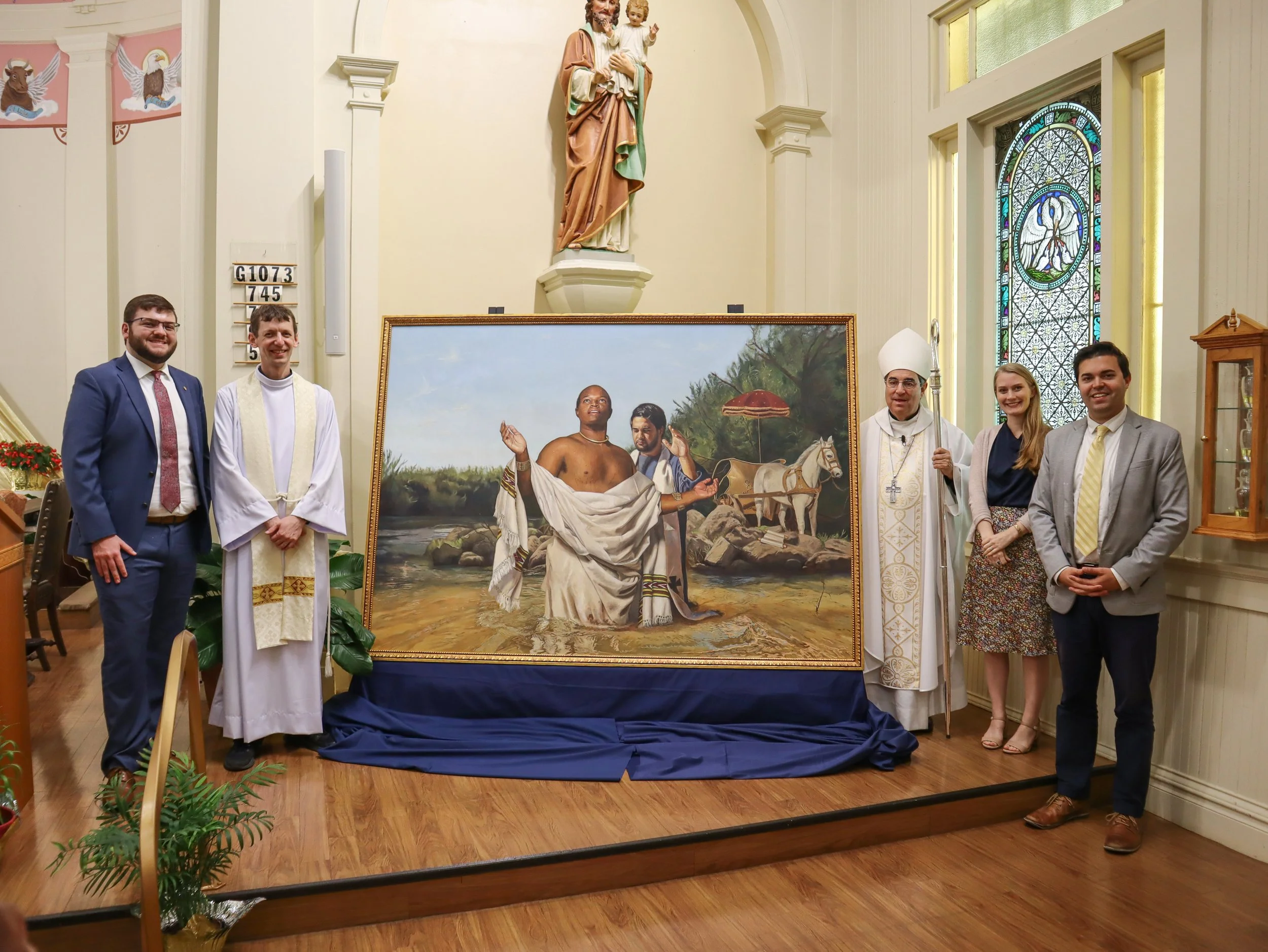The Baptism of the Ethiopian
On Sunday, May 7th, 2023, The St. Louis IX Art Society installed its most recent SL9 Art Fund painting in St. Philip Catholic Church in Vacherie, LA. The 5’x7’ oil painting, entitled The Baptism of the Ethiopian, was completed by SL9 Artist Blair Gordy Piras of Blair Barlow Art. This piece was unveiled and blessed during the 4:00 PM Mass at St. Philip’s, which was presided over by Bishop Michael Duca of the Diocese of Baton Rouge, with Fr. Matthew McCaughey, Pastor of St. Philip Catholic Church, as the concelebrant.
“The Baptism of the Ethiopian,” writes Piras, “depicts the scene as recorded in Acts of the Apostles 8. Scripture tells us the Ethiopian was a court official for ‘Candace, the queen of the Ethiopians’ (Acts 27). When we read the term Ethiopian today, we think of the modern country of Ethiopia; however, at the time this Scripture was written, this term was used to describe a much larger geographical area and ethnic group in Africa. We read that the Ethiopian man, who is later identified as Simeon Bachos by St. Irenaeus of Lyon, was returning from Jerusalem, where he had been worshiping, and was reading from Isaiah in his chariot. The Holy Spirit led St. Philip to him, and, hearing the Ethiopian man reading, Philip asked, ‘Do you understand what you are reading?’ The Ethiopian man replied, ‘How can I, unless someone guides me?’ He then invited Philip to sit beside him. The Ethiopian man asked who the writer was speaking about, and St. Philip interpreted the Scripture and shared the good news of Jesus Christ with him. The man, moved by the Gospel, upon seeing water, exclaimed, ‘What is to prevent me from being baptized?’”
Piras continues, “In the painting we see the Ethiopian man and St. Philip standing in water, the baptism having just occurred. The Ethiopian, having been immersed, rejoices as he emerges from the water. He is clothed in a white gabi, a traditional African garment, here representing his baptismal garb. St. Philip fervently prays the post baptismal blessing over him. The water below seems alive with movement, innumerable ripples animating it, as if to signify the living waters of baptism. On the nearby rocky shore we see an open scroll which demonstrates how his conversion was inspired by the opening of the Scriptures. Behind this we see his canopy-covered chariot and seemingly apprehensive horse, who has just witnessed his master plunging into the water three times. The Ethiopian man’s arms are wide open, palms up in a gesture of rejoicing and openness. He looks up to heaven with an expression of joy, to show his receptivity to the Holy Spirit. He is meant to embody the spirit of the African people, whose great joy is a gift to our Church! The sky above is expansive, filling much of the painting, and the clouds seem to rejoice along with the man. We see cirrus clouds, caused by strong winds, which seem also to reach up, reminding us of the movement of the Holy Spirit brooding over the waters.The Ethiopian man wears gold bracelets, modeled after archeological finds from the region and time period, which signify his royal status, and a gold neck cuff. St. Philip wears a stole with a simple black cross.”
As Christians, we all pass through the waters of baptism as we enter the Church and are cleansed of original sin. We are united to Christ. With him we die to sin and rise to new life. The Baptism of the Ethiopian will hang above the baptismal font in St. Philip Catholic Church in Vacherie, LA. This scene was chosen to highlight the history of Christianity entering Africa through the person of the Ethiopian eunuch. It is recorded elsewhere that Simeon Bachos went on to evangelize and bring the faith to his land and people. Through his joyous conversion, many people came to know and love Christ, and his Church took root among the African people.
This painting was made possible by Knights of Columbus Advisor, Matthew Maurin, through the St. Louis IX Art Fund.
To purchase a 12"x17" limited edition, signed print of The Baptism of the Ethiopian, click here.



